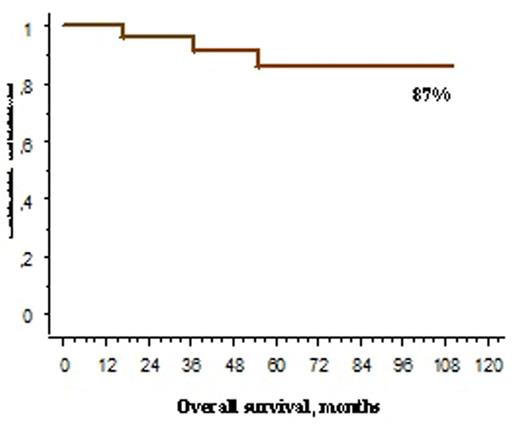Abstract
Background: Primary bone lymphoma (PBL) accounts for about 5% of extranodal lymphomas, the most common type are Diffuse Large B-cell Lymphoma (PBL-DLBCL). R-CHOP chemotherapy combined with or no radiation therapy can induce 5-year overall and progression free survival about 63% and 60% for localized-stage and only 41% and 35% for advanced stage and with adverse factors (AF). Due to the rarity of the disease the optimal treatment strategy still remains unknown. Further research is thus needed to increase treatment efficacy for patients with advanced stage PBL-DLBCL and with AF.
Aims: To evaluate the efficacy of mNHL-BFM-90 program in adult patients with advanced stage PBL-DLBCL and with AF.
Methods: Twenty three previously untreated pts with PBL-DLBCL underwent mNHL-BFM-90 treatment between May 2007 and July 2014; mean age 41 years (range 17-65); age ≥60 years 3 pts (13,6%); M\F=14\9. Tumor stage according to the Ann-Arbor classification: stage I (involvement of 1 bone) - 7 pts (30,4%), II (involvement of regional lymph nodes) - 3 pts (13%), IV (multiple bone involvement) - 13 pts (56,6%); stage >I 16 pts (69,5%). All pts with stage I had large-size tumors (>6sm) with soft tissue contact invasion. LDH elevation was observed in 10 pts (43,5%), B-symptoms in 15 pts (65%), large-size tumors - 20 pts (87%). The most common tumor sites were the skull bones, vertebrae, and femur. All patients received treatment according to the mNHL-BFM-90 intensive program This program was modified in the following way: adriamycin was administered on the 3rd day of course AA at a dose 50 mg/m2; methotrexate was administered on the 1st day of course C at a dose 1.0 g/m2 for 12 hours. All patients underwent from 4 to 6 courses. Twelve (52%) pts received rituximab on day 0 prior to each course of therapy. Five pts received radiotherapy, all pts received intrathecal prophylaxis of central nervous system (CNS) involvement.
Results. Complete remissions were achieved in 23 pts (100%). Relapses were observed in three patients in 6, 9 and 40 months after completion of treatment. From 2 pts with early relapse, one was diagnosed as «double-expression lymphoma» (MYC expression >70%, BCL2 >60%), both pts proliferation index Ki-67 accounted 100%. All 3 pts received salvage therapy and died from progression of disease.
With a median follow-up of 69 months (range 17-110) both progression-free and overall survival of 23 pts constituted 87%. Grades 3, 4 hematological toxicity was observed in all pts. No deaths related to mNHL-BFM-90 treatment occurred. No second malignancies were observed.
Conclusion The mNHL-BFM-90 demonstrated high efficacy and acceptable toxicity in patients with advanced-stage PBL-DLBCL and with AF.
No relevant conflicts of interest to declare.
Author notes
Asterisk with author names denotes non-ASH members.


This feature is available to Subscribers Only
Sign In or Create an Account Close Modal